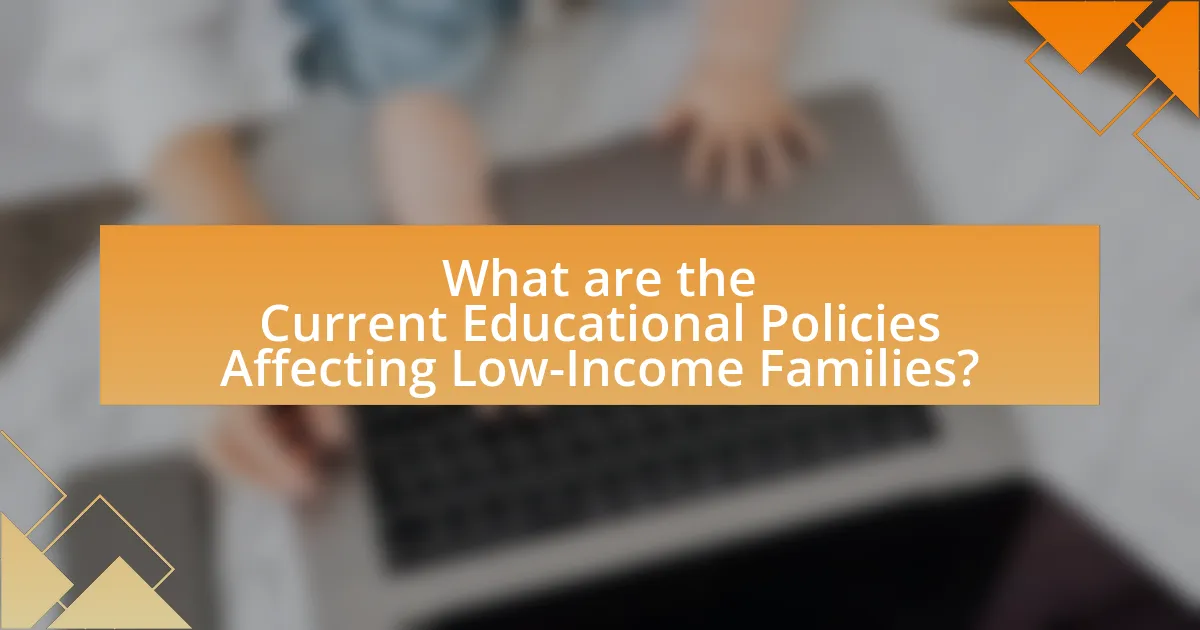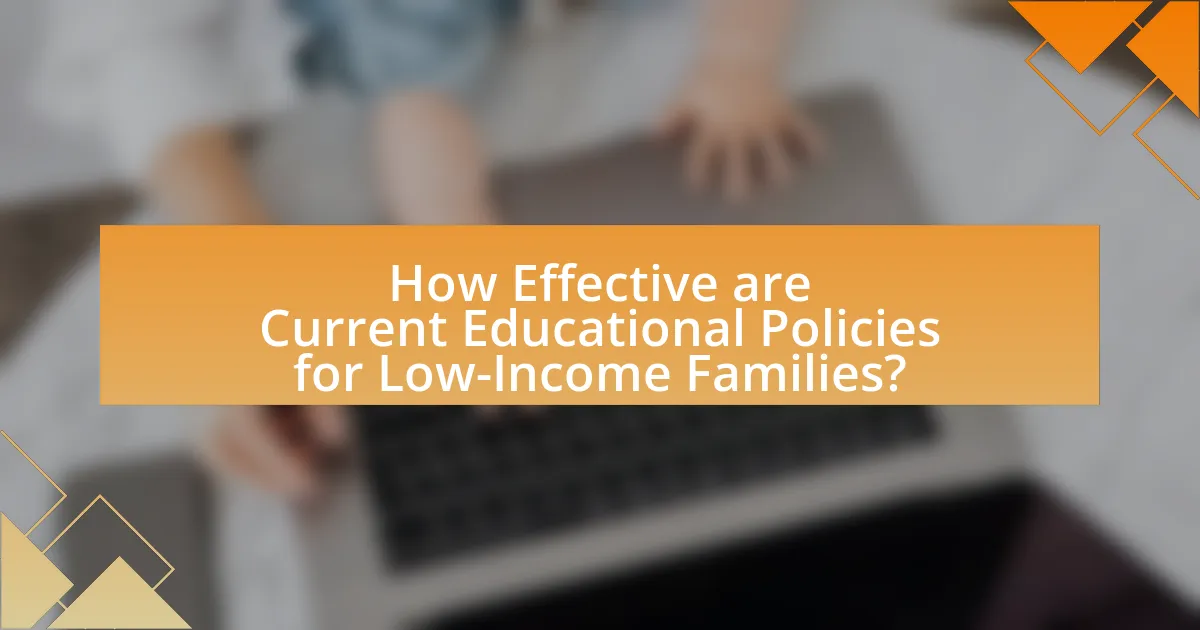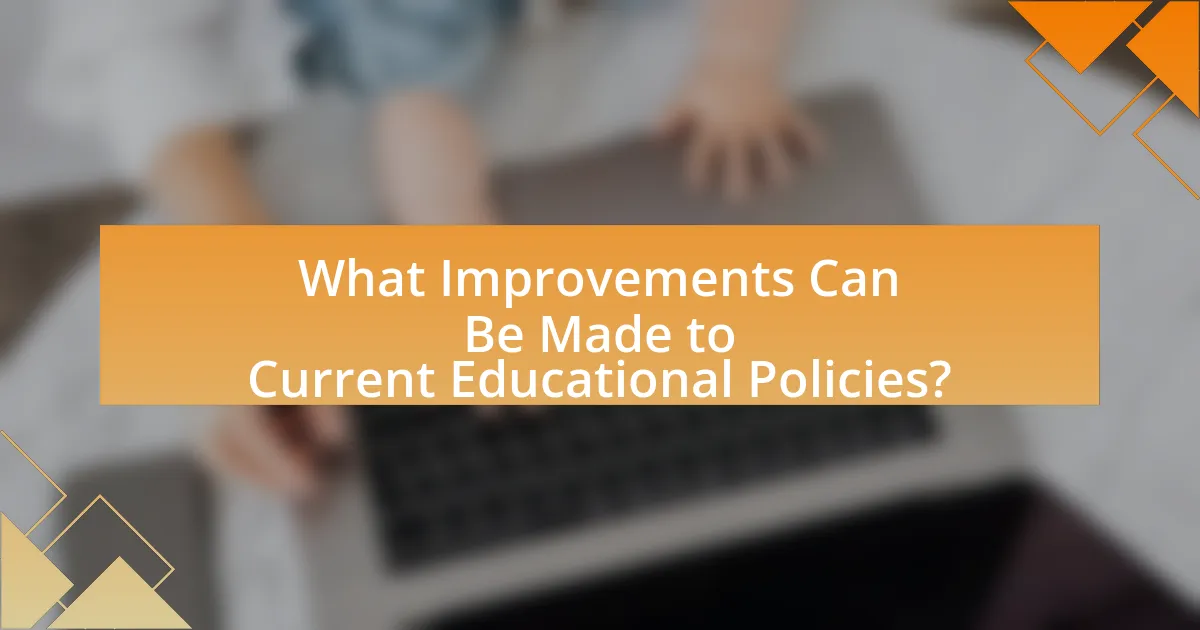The article evaluates the effectiveness of current educational policies impacting low-income families, focusing on initiatives such as Title I funding and the Individuals with Disabilities Education Act (IDEA). It examines how these policies aim to reduce educational disparities by providing additional resources and support, including subsidized childcare and free school meals. The article also discusses the challenges low-income families face in accessing education, the role of socioeconomic factors, and the barriers within the educational system. Furthermore, it analyzes the effectiveness of these policies through metrics like student achievement and graduation rates, while suggesting improvements to enhance educational access and outcomes for disadvantaged populations.

What are the Current Educational Policies Affecting Low-Income Families?
Current educational policies affecting low-income families include initiatives such as Title I funding, which allocates federal resources to schools with high percentages of low-income students, and the Individuals with Disabilities Education Act (IDEA), ensuring special education services are accessible. These policies aim to reduce educational disparities by providing additional support and resources to underfunded schools. For instance, Title I funding has been shown to improve academic outcomes in schools serving low-income populations, with studies indicating that schools receiving this funding often see increased student achievement and engagement.
How do these policies aim to support low-income families?
These policies aim to support low-income families by providing access to affordable education and resources that enhance learning opportunities. For instance, initiatives such as subsidized childcare and free or reduced-price school meals directly alleviate financial burdens, allowing families to allocate more resources towards essential needs. Additionally, funding for after-school programs and tutoring services helps bridge educational gaps, ensuring that children from low-income households receive the support necessary to succeed academically. Research indicates that such policies can lead to improved educational outcomes, as evidenced by studies showing that students from low-income families who participate in these programs demonstrate higher academic performance and increased graduation rates.
What specific programs are included in these educational policies?
The specific programs included in educational policies aimed at low-income families typically encompass initiatives such as Title I funding, which provides financial assistance to schools with high percentages of low-income students, and the Free and Reduced Price Lunch Program, which ensures access to nutritious meals for eligible children. Additionally, programs like Head Start offer early childhood education and support services to low-income families, while the Individuals with Disabilities Education Act (IDEA) ensures that children with disabilities receive appropriate educational services. These programs are designed to address educational disparities and improve outcomes for low-income students.
How are these policies funded and implemented?
Educational policies aimed at low-income families are primarily funded through federal, state, and local government budgets, as well as grants from private organizations and foundations. For instance, programs like Title I funding under the Elementary and Secondary Education Act allocate federal resources specifically to schools serving low-income students, ensuring that they receive additional financial support to improve educational outcomes. Implementation occurs through a structured process involving school districts, which develop plans to utilize these funds effectively, often incorporating community input and aligning with state educational standards. Evidence of this funding and implementation framework can be seen in the National Center for Education Statistics reports, which detail how federal and state funding is distributed to support educational initiatives for disadvantaged populations.
What challenges do low-income families face in accessing education?
Low-income families face significant challenges in accessing education, primarily due to financial constraints, lack of resources, and systemic barriers. Financial constraints limit their ability to afford tuition, transportation, and necessary school supplies, which directly impacts their children’s educational opportunities. According to the National Center for Education Statistics, students from low-income families are less likely to enroll in preschool programs and more likely to drop out of high school compared to their higher-income peers. Additionally, these families often reside in underfunded school districts, which can lead to overcrowded classrooms and insufficient educational materials, further hindering academic success. Systemic barriers, such as limited access to technology and internet connectivity, exacerbate these issues, making it difficult for low-income students to engage in remote learning or complete assignments.
How do socioeconomic factors impact educational access?
Socioeconomic factors significantly impact educational access by influencing the resources available to students and their families. Families with lower income often face barriers such as inadequate funding for schools in their neighborhoods, limited access to educational materials, and fewer opportunities for extracurricular activities. According to the National Center for Education Statistics, students from low-income families are less likely to have access to advanced coursework and experienced teachers, which can hinder their academic performance and future opportunities. Additionally, socioeconomic status affects parental involvement in education, as parents with lower income may work multiple jobs, leaving them with less time to engage in their children’s schooling. This lack of engagement can further exacerbate educational disparities.
What barriers exist within the educational system for low-income families?
Barriers within the educational system for low-income families include inadequate funding, lack of access to resources, and systemic inequalities. Inadequate funding often results in under-resourced schools, which struggle to provide essential services such as tutoring, extracurricular activities, and updated learning materials. According to the National Center for Education Statistics, schools in low-income areas receive significantly less funding per student compared to those in wealthier districts. Additionally, low-income families frequently face challenges accessing technology and internet services, which are crucial for modern education, particularly in remote learning scenarios. Systemic inequalities, such as racial and socioeconomic biases, further exacerbate these barriers, leading to lower academic performance and higher dropout rates among students from low-income backgrounds.

How Effective are Current Educational Policies for Low-Income Families?
Current educational policies for low-income families are moderately effective, with evidence showing improvements in access to resources and support services. For instance, programs like Title I funding have increased financial support for schools serving low-income students, resulting in better academic outcomes. According to the National Center for Education Statistics, schools receiving Title I funds have seen a 10% increase in student proficiency rates in reading and math over the past decade. However, challenges remain, such as disparities in funding distribution and the need for more comprehensive support systems, which can hinder overall effectiveness.
What metrics are used to evaluate the effectiveness of these policies?
Metrics used to evaluate the effectiveness of educational policies on low-income families include student achievement scores, graduation rates, attendance rates, and parental engagement levels. Student achievement scores, such as standardized test results, provide quantitative data on academic performance, while graduation rates indicate the percentage of students completing their education. Attendance rates reflect student participation, which is crucial for learning outcomes. Parental engagement levels assess the involvement of families in their children’s education, which has been shown to correlate with student success. These metrics collectively offer a comprehensive view of policy impact on educational outcomes for low-income families.
How do we measure academic performance among low-income students?
Academic performance among low-income students is measured through standardized test scores, grade point averages (GPAs), and attendance rates. Standardized tests provide a uniform metric for assessing knowledge and skills across various subjects, while GPAs reflect overall academic achievement over time. Attendance rates are also critical, as consistent attendance is linked to better academic outcomes. Research indicates that low-income students often face barriers that can affect these metrics, such as limited access to resources and support systems, which can skew performance results. For instance, a study by the National Center for Education Statistics found that socioeconomic status significantly correlates with academic achievement, highlighting the need for targeted interventions to support low-income students.
What role does parental involvement play in educational outcomes?
Parental involvement significantly enhances educational outcomes for children. Research indicates that students with engaged parents tend to achieve higher grades, have better attendance, and exhibit improved behavior in school. A study by the National Center for Education Statistics found that students whose parents are actively involved in their education are 20% more likely to graduate from high school compared to those with less parental engagement. This involvement can take various forms, including attending school events, helping with homework, and maintaining communication with teachers, all of which contribute to a supportive learning environment that fosters academic success.
What evidence exists regarding the success of these policies?
Evidence regarding the success of educational policies aimed at low-income families includes significant improvements in student performance and increased access to resources. For instance, studies have shown that the implementation of the Title I program, which provides federal funding to schools serving low-income students, has led to a measurable increase in reading and math scores among participants. According to the National Center for Education Statistics, schools receiving Title I funding reported a 10% increase in proficiency rates over a five-year period. Additionally, research published in the Journal of Policy Analysis and Management indicates that early childhood education programs, such as Head Start, have resulted in long-term academic benefits, with participants showing higher graduation rates and better college enrollment statistics compared to their peers. These findings collectively demonstrate that targeted educational policies can effectively enhance educational outcomes for low-income families.
What studies have been conducted on the impact of educational policies?
Numerous studies have been conducted on the impact of educational policies, particularly focusing on low-income families. For instance, the study “The Impact of School Finance Reform on the Distribution of School Spending” by Bruce Baker and colleagues (2016) analyzed how changes in funding policies affected educational equity and outcomes for low-income students. Another significant research is “The Effects of Universal Pre-K on Child Development” by Yoshikawa et al. (2013), which evaluated the long-term benefits of universal pre-kindergarten policies on disadvantaged children. Additionally, the “Every Student Succeeds Act (ESSA) and Its Impact on Educational Equity” report by the Center for American Progress (2016) examined how state-level implementation of ESSA influenced educational opportunities for low-income families. These studies provide concrete evidence of how educational policies shape the experiences and outcomes of low-income students.
How do these policies compare to those in other socioeconomic contexts?
Current educational policies aimed at low-income families often prioritize access to resources and support systems, which can differ significantly from policies in higher socioeconomic contexts that may focus on advanced educational opportunities and enrichment programs. For instance, in low-income areas, policies may include increased funding for public schools, free meal programs, and after-school tutoring, while in affluent areas, policies might emphasize gifted and talented programs, technology integration, and extracurricular activities. Research indicates that these disparities in policy focus can lead to unequal educational outcomes, as evidenced by the National Assessment of Educational Progress (NAEP) data showing that students from low-income families consistently score lower in reading and math compared to their higher-income peers.

What Improvements Can Be Made to Current Educational Policies?
Improvements to current educational policies can include increasing funding for low-income schools, implementing universal access to early childhood education, and enhancing support services for students and families. Increased funding can address resource disparities, as studies show that schools in low-income areas often receive significantly less funding, impacting educational outcomes. Universal access to early childhood education has been linked to improved long-term academic performance, particularly for disadvantaged children, as evidenced by research from the National Institute for Early Education Research. Additionally, enhancing support services, such as mental health resources and tutoring programs, can help address the unique challenges faced by low-income families, leading to better educational engagement and success.
How can policies be adjusted to better serve low-income families?
Policies can be adjusted to better serve low-income families by increasing funding for targeted educational programs and resources. For instance, implementing needs-based funding models can ensure that schools in low-income areas receive adequate financial support, which has been shown to improve educational outcomes. Research from the National Bureau of Economic Research indicates that increased funding in disadvantaged schools leads to higher student achievement and graduation rates. Additionally, policies that provide access to affordable childcare and after-school programs can alleviate the burden on low-income families, allowing parents to pursue employment or education while ensuring their children receive quality care and support.
What best practices from successful programs can be adopted?
Successful programs often adopt best practices such as targeted support services, community engagement, and data-driven decision-making. Targeted support services, like tutoring and mentoring, have been shown to improve academic outcomes for low-income students, as evidenced by the success of programs like the Harlem Children’s Zone, which reported significant increases in student performance. Community engagement fosters a supportive environment, as seen in the Parent-Child Home Program, which emphasizes parental involvement and has demonstrated improved literacy rates among participating families. Data-driven decision-making allows programs to assess effectiveness and adapt strategies, a practice highlighted in the work of the Institute of Education Sciences, which emphasizes the importance of using evidence to inform educational policies. These practices collectively enhance the effectiveness of educational initiatives aimed at low-income families.
How can community involvement enhance policy effectiveness?
Community involvement enhances policy effectiveness by ensuring that policies are tailored to the specific needs and circumstances of the community they serve. When community members actively participate in the policy-making process, they provide valuable insights and feedback that can lead to more relevant and impactful educational policies. For instance, research by the National Education Association indicates that schools with strong community engagement see improved student outcomes, as policies reflect the priorities and challenges faced by low-income families. This alignment between policy and community needs fosters greater trust and cooperation, ultimately leading to more successful implementation and sustainability of educational initiatives.
What are the implications of ineffective educational policies?
Ineffective educational policies lead to significant negative outcomes for students, particularly among low-income families. These policies often result in inadequate funding, which can diminish the quality of education, limit access to resources, and increase class sizes. For instance, a study by the National Center for Education Statistics found that schools in low-income areas receive about $1,000 less per student compared to those in wealthier districts, exacerbating educational disparities. Additionally, ineffective policies can contribute to higher dropout rates; according to the U.S. Department of Education, students from low-income backgrounds are more likely to leave school without a diploma when educational policies fail to address their specific needs. Ultimately, these implications hinder social mobility and perpetuate cycles of poverty, as education is a critical factor in economic advancement.
How do poor educational outcomes affect low-income families in the long term?
Poor educational outcomes significantly hinder the long-term economic stability of low-income families. When children from low-income households receive inadequate education, they are less likely to attain higher-paying jobs, leading to a cycle of poverty that persists across generations. Research indicates that individuals who do not complete high school earn, on average, $10,000 less annually than their peers who graduate, which compounds over a lifetime, resulting in substantial financial disadvantages. Furthermore, low educational attainment correlates with higher rates of unemployment and reliance on social welfare programs, which places additional strain on family resources and limits opportunities for upward mobility. This cycle reinforces socioeconomic disparities, making it increasingly difficult for low-income families to break free from poverty.
What are the broader societal impacts of educational inequity?
Educational inequity leads to significant societal impacts, including increased poverty rates, reduced economic mobility, and heightened social stratification. When access to quality education is unequal, individuals from low-income families often lack the skills and qualifications necessary for well-paying jobs, perpetuating cycles of poverty. According to the National Center for Education Statistics, students from low-income backgrounds are less likely to graduate high school and pursue higher education, which directly correlates with lower lifetime earnings. Furthermore, educational inequity contributes to social divisions, as communities with underfunded schools experience higher crime rates and lower civic engagement, ultimately destabilizing societal cohesion.
What practical steps can be taken to improve educational access for low-income families?
To improve educational access for low-income families, implementing targeted financial assistance programs is essential. These programs can provide scholarships, grants, and subsidies specifically designed to cover tuition and related educational expenses, thereby reducing the financial burden on families. For instance, the U.S. Department of Education reported that federal Pell Grants have helped millions of low-income students afford college, demonstrating the effectiveness of financial aid in increasing access to education. Additionally, expanding access to affordable childcare services can enable parents to pursue educational opportunities without the constraint of childcare costs, further enhancing educational access for their children.



